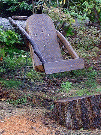 |
The
main support for this chair is the horizontal trunk of the Port
Orford Cedar, which is still attached to its roots. It is called a
catapult chair because if the chain breaks, the chair will catapult
you across to the other side of the garden.
When the
cedar uprooted in the windstorm, the weight of the top held the
trunk horizontal. As soon as I removed all but the lower fifteen
feet for the bench, the tree spring back upright with a powerful
force. I dug a hole, filled it with 600 pounds of concrete, winched
the tree back down again, and held it in place with a chain.
|

